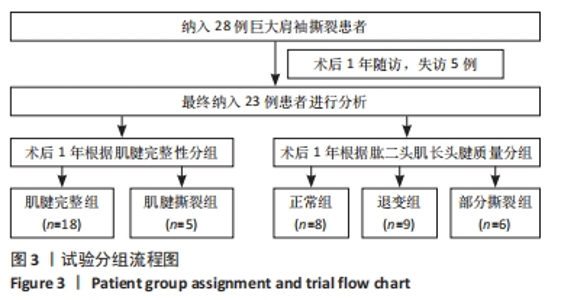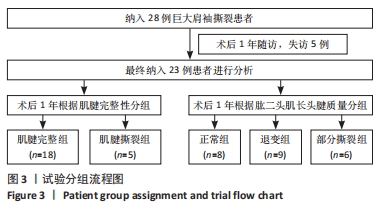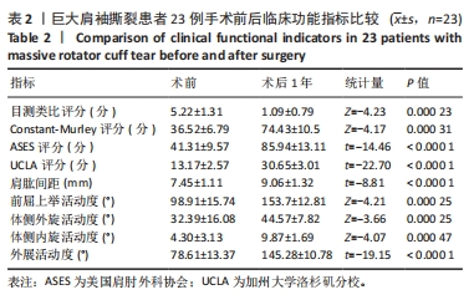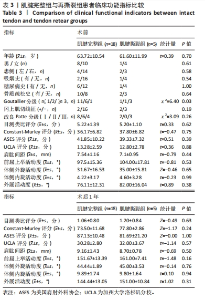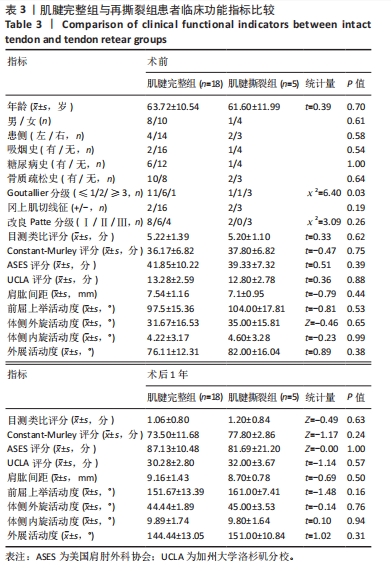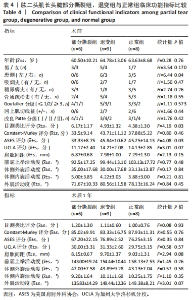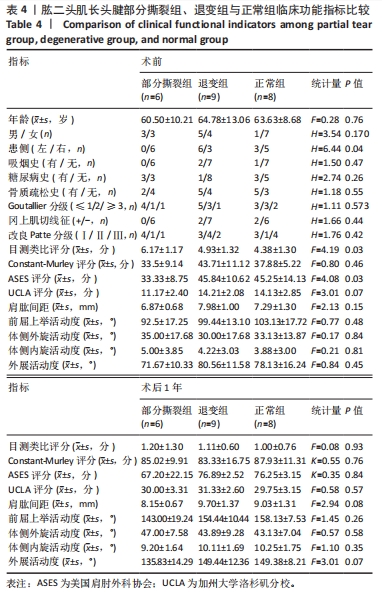Chinese Journal of Tissue Engineering Research ›› 2024, Vol. 28 ›› Issue (35): 5675-5680.doi: 10.12307/2024.596
Previous Articles Next Articles
Arthroscopic long head of the biceps tendon transposition for augmented repair of massive rotator cuff tear
Ding Kai1, Yao Yujing1, Li Zhipeng1, Wang Lei2, Gu Changyuan2, Shu Hao2, Sun Luning2
- 1Affiliated Hospital of Nanjing University of Chinese Medicine, Nanjing 210004, Jiangsu Province, China; 2Orthopedic Center for Sports Medicine, Jiangsu Province Hospital of Chinese Medicine, Nanjing 210004, Jiangsu Province, China
-
Received:2023-11-06Accepted:2023-12-15Online:2024-12-18Published:2024-03-15 -
Contact:Sun Luning, MD, Chief physician, Master’s supervisor, Orthopedic Center for Sports Medicine, Jiangsu Province Hospital of Chinese Medicine, Nanjing 210004, Jiangsu Province, China -
About author:Ding Kai, Master candidate, Affiliated Hospital of Nanjing University of Chinese Medicine, Nanjing 210004, Jiangsu Province, China -
Supported by:The Hospital Level Project of Jiangsu Province Hospital of Chinese Medicine, No. k2022yzr23 (to SLN)
CLC Number:
Cite this article
Ding Kai, Yao Yujing, Li Zhipeng, Wang Lei, Gu Changyuan, Shu Hao, Sun Luning. Arthroscopic long head of the biceps tendon transposition for augmented repair of massive rotator cuff tear[J]. Chinese Journal of Tissue Engineering Research, 2024, 28(35): 5675-5680.
share this article
Add to citation manager EndNote|Reference Manager|ProCite|BibTeX|RefWorks
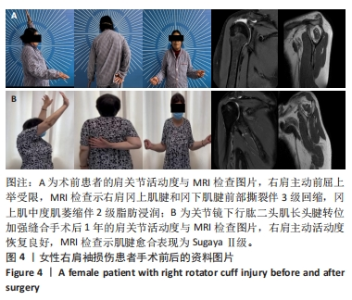
2.5 手术前后影像学评价 纳入23例患者术前平均肩肱间距为(7.45±1.11) mm,术后1年随访时肩肱间距平均为(9.06±1.32) mm,手术前后平均肩肱间距比较差异有显著性意义(P < 0.05),见表2。 术后3个月MRI检查见SugayaⅡ型15例,Ⅲ型6例,Ⅳ型1例,Ⅴ型1例;术后1年MRI检查见SugayaⅠ型1例,Ⅱ型15例,Ⅲ型2例,Ⅳ型4例,Ⅴ型1例。 2.6 典型病例 66岁女性右肩袖损伤患者,右肩主动前屈上举受限,MRI检查示右肩冈上肌腱和冈下肌腱前部撕裂伴3级回缩,冈上肌中度肌萎缩伴2级脂肪浸润,进行关节镜下行肱二头肌长头腱转位加强缝合手术治疗。术后最终随访时右肩主动活动度恢复良好,MRI检查示肌腱愈合表现为SugayaⅡ级。该患者手术前后的资料图片,见图4。"
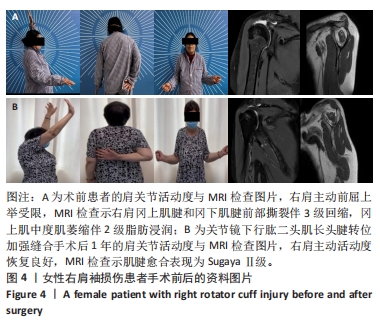
| [1] MURRELL GA, WALTON JR. Diagnosis of rotator cuff tears. Lancet. 2001; 357(9258):769-770. [2] GODENECHE A, FREYCHET B, LANZETTI RM, et al. Should massive rotator cuff tears be reconstructed even when only partially repairable? Knee Surg Sports Traumatol Arthrosc. 2017;25(7):2164-2173. [3] DOIRON-CADRIN P, LAFRANCE S, SAULNIER M, et al. Shoulder Rotator Cuff Disorders: A Systematic Review of Clinical Practice Guidelines and Semantic Analyses of Recommendations. Arch Phys Med Rehabil. 2020;101(7): 1233-1242. [4] 王明新,刘玉杰,王耀霆,等.不可修复肩袖损伤的治疗研究进展[J].中国矫形外科杂志,2023,31(3):237-241. [5] DEORIO JK, COFIELD RH. Results of a second attempt at surgical repair of a failed initial rotator-cuff repair. J Bone Joint Surg Am. 1984;66(4):563-567. [6] GERBER C, FUCHS B, HODLER J. The results of repair of massive tears of the rotator cuff. J Bone Joint Surg Am. 2000;82(4):505-515. [7] LONGO UG, CARNEVALE A, PIERGENTILI I, et al. Retear rates after rotator cuff surgery: a systematic review and meta-analysis. BMC Musculoskelet Disord. 2021;22(1):749. [8] YANG Z, ZHANG M, LIU T, et al. Does the Fatty Infiltration Influence the Re-tear Rate and Functional Outcome After Rotator Cuff Repair? A Systematic Review and Meta-analysis. Indian J Orthop. 2023;57(2):227-237. [9] BOUTSIADIS A, CHEN S, JIANG C, et al. Long Head of the Biceps as a Suitable Available Local Tissue Autograft for Superior Capsular Reconstruction: “The Chinese Way”. Arthrosc Tech. 2017;6(5):e1559-e1566. [10] KIM JH, LEE HJ, PARK TY, et al. Preliminary outcomes of arthroscopic biceps rerouting for the treatment of large to massive rotator cuff tears. J Shoulder Elbow Surg. 2021;30(6):1384-1392. [11] GOUTALLIER D, POSTEL JM, GLEYZE P, et al. Influence of cuff muscle fatty degeneration on anatomic and functional outcomes after simple suture of full-thickness tears. J Shoulder Elbow Surg. 2003;12(6):550-554. [12] FUCHS B, WEISHAUPT D, ZANETTI M, et al. Fatty degeneration of the muscles of the rotator cuff: assessment by computed tomography versus magnetic resonance imaging. J Shoulder Elbow Surg. 1999;8(6):599-605. [13] ZANETTI M, GERBER C, HODLER J. Quantitative assessment of the muscles of the rotator cuff with magnetic resonance imaging. Invest Radiol. 1998; 33(3):163-170. [14] GUO S, ZHU Y, SONG G, et al. Assessment of Tendon Retraction in Large to Massive Rotator Cuff Tears: A Modified Patte Classification Based on 2 Coronal Sections on Preoperative Magnetic Resonance Imaging With Higher Specificity on Predicting Reparability. Arthroscopy. 2020;36(11):2822-2830. [15] 黄巍,钟正,胡益华,等.多种影像学方法测量肩肱距离与肩峰下撞击综合征的相关性分析[J].湖南师范大学学报(医学版),2020,17(6):28-31. [16] SUGAYA H, MAEDA K, MATSUKI K, et al. Functional and structural outcome after arthroscopic full-thickness rotator cuff repair: single-row versus dual-row fixation. Arthroscopy. 2005;21(11):1307-1316. [17] GUEVARA JA, ENTEZARI V, HO JC, et al. An Update on Surgical Management of the Repairable Large-to-Massive Rotator Cuff Tear. J Bone Joint Surg Am. 2020;102(19):1742-1754. [18] TANAKA S, GOTOH M, TANAKA K, et al. Functional and Structural Outcomes After Retears of Arthroscopically Repaired Large and Massive Rotator Cuff Tears. Orthop J Sports Med. 2021;9(10):941640808. [19] KIM KT, KIM GH, CHA DH, et al. A Comparison of Clinical Outcomes in Rotator Cuff Re-Tear Patients Who Had Either an Arthroscopic Primary Repair or Arthroscopic Patch Augmentation for Large-to-Massive Rotator Cuff Tears. Diagnostics (Basel). 2023;13(11):1961. [20] HAN F, KONG CH, HASAN MY, et al. Superior capsular reconstruction for irreparable supraspinatus tendon tears using the long head of biceps: A biomechanical study on cadavers. Orthop Traumatol Surg Res. 2019;105(2): 257-263. [21] EL-SHAAR R, SOIN S, NICANDRI G, et al. Superior Capsular Reconstruction With a Long Head of the Biceps Tendon Autograft: A Cadaveric Study. Orthop J Sports Med. 2018;6(7):1809832789. [22] CHEPPALLI NS, PURUDAPPA PP, METIKALA S, et al. Superior Capsular Reconstruction Using the Biceps Tendon in the Treatment of Irreparable Massive Rotator Cuff Tears Improves Patient-Reported Outcome Scores: A Systematic Review. Arthrosc Sports Med Rehabil. 2022;4(3):e1235-e1243. [23] HERMANOWICZ K, GORALCZYK A, MALINOWSKI K, et al. Long Head Biceps Tendon-Natural Patch for Massive Irreparable Rotator Cuff Tears. Arthrosc Tech. 2018;7(5):e473-e478. [24] 康运康,郭标,许健,等.关节镜下肱二头肌长头腱转位术联合Swivelock锚钉双固定治疗巨大及不可修复肩袖撕裂[J].中国修复重建外科杂志,2022,36(12):1459-1464. [25] 尚西亮,吕婧仪,陈疾忤,等.关节镜下肱二头肌长头腱转位固定辅助替代上关节囊重建(Chinese Way)修补巨大及不可修复肩袖撕裂的临床疗效[J].中国运动医学杂志,2019,38(8):652-657. [26] RHEE SM, YOUN SM, PARK JH, et al. Biceps Rerouting for Semirigid Large-to-Massive Rotator Cuff Tears. Arthroscopy. 2021;37(9):2769-2779. [27] LLINAS PJ, BAILIE DS, SANCHEZ DA, et al. Partial Superior Capsular Reconstruction to Augment Arthroscopic Repair of Massive Rotator Cuff Tears Using Autogenous Biceps Tendon: Effect on Retear Rate. Am J Sports Med. 2022;50(11):3064-3072. [28] CHIANG CH, SHAW L, CHIH WH, et al. Modified Superior Capsule Reconstruction Using the Long Head of the Biceps Tendon as Reinforcement to Rotator Cuff Repair Lowers Retear Rate in Large to Massive Reparable Rotator Cuff Tears. Arthroscopy. 2021;37(8):2420-2431. [29] KIM JY, PARK JS, RHEE YG. Can Preoperative Magnetic Resonance Imaging Predict the Reparability of Massive Rotator Cuff Tears? Am J Sports Med. 2017; 45(7):1654-1663. [30] KUPTNIRATSAIKUL V, LAOHATHAIMONGKOL T, UMPRAI V, et al. Pre-operative factors correlated with arthroscopic reparability of large-to-massive rotator cuff tears. BMC Musculoskelet Disord. 2019;20(1):111. [31] KIM SC, SHIM SB, KIM WJ, et al. Preoperative rotator cuff tendon integrity, tear size, and muscle atrophy and fatty infiltration are associated with structural outcomes of arthroscopic revision rotator cuff repair. Knee Surg Sports Traumatol Arthrosc. 2022;30(6):2029-2038. [32] ARDEBOL J, HWANG S, PAK T, et al. Female Sex and Higher Infraspinatus Fatty Infiltration Are Linked to Dissatisfaction at a Minimum Follow-Up of 4 Years after Arthroscopic Repair of Massive Rotator Cuff Tears. Arthrosc Sports Med Rehabil. 2023;5(3):e731-e737. [33] KIM C, LEE YJ, KIM SJ, et al. Subscapularis re-tears associated with preoperative advanced fatty infiltration and greater subscapularis involvement, leading to inferior functional outcomes and decreased acromiohumeral distance. Knee Surg Sports Traumatol Arthrosc. 2021;29(8): 2624-2630. [34] KAO JT, CHIU CH, HSU KY, et al. Arthroscopic diagnosis of long head of biceps tendon instability in refractory anterior shoulder pain: A comparison study between pulley tear and non-tear lesions. Biomed J. 2023l46(1):163-169. [35] IZUMI M, HARADA Y, KAJITA Y, et al. Expression of Substance P and Nerve Growth Factor in Degenerative Long Head of Biceps Tendon in Patients with Painful Rotator Cuff Tear. J Pain Res. 2021;14:2481-2490. [36] CHENG YH, WU CT, CHIU CH, et al. Arthroscopic Superior Capsule Reconstruction With Fascia Lata Autograft And In-Situ Biceps Tendon Augmentation: Feasible Outcomes After Minimum Two-Year Follow-Up. Arthrosc Sports Med Rehabil. 2022;4(5):e1675-e1682. |
| [1] | He Rongzhen, Ying Lyufang, He Xingwen, Chen Chuanshun, Yin Yuesong, Zhang Kexiang, Wang Zili. Effect of ginsenoside Rg1 on muscle degeneration after massive rotator cuff injury in mice [J]. Chinese Journal of Tissue Engineering Research, 2024, 28(32): 5136-5140. |
| [2] | Xie Wei, Zhao Jingjing, Hao Cheng, Li Zi, Fang Zhenhua. Treatment of high ankle sprains with Suture-button elastic fixation assisted by arthroscopy [J]. Chinese Journal of Tissue Engineering Research, 2024, 28(30): 4848-4853. |
| [3] | Li Xiaomin, Tian Xiangdong, Tan Yetong, Zhu Guangyu, Wang Rongtian, Wang Jian, Xue Zhipeng, Ma Sheng, Hu Yuanyi, Huang Ye, Ding Tiansong. Changes of lower limb force line and knee function after high tibial osteotomy in osteoporotic medial ventricular knee osteoarthritis [J]. Chinese Journal of Tissue Engineering Research, 2023, 27(9): 1325-1329. |
| [4] | Zheng Bo, Zhang Xiuli, Zhou Hao, He Zebi, Zhou Jin, Zhou Weiyun, Li Peng. Arthroscopy-assisted locking hollow screw fixation and open reduction plate internal fixation in the treatment of Schatzker II-III tibial plateau fractures: early CT evaluation [J]. Chinese Journal of Tissue Engineering Research, 2023, 27(9): 1410-1416. |
| [5] | Liu Xiuqi, Chen Fang, Zhong Hehe, Xiong Huazhang, Lyu Guoqing, Wu Shuhong, Liu Yi. Short-term follow-up of modified elastic fixation Latarjet procedure for recurrent anterior dislocation of shoulder with obvious glenoid bone defect [J]. Chinese Journal of Tissue Engineering Research, 2023, 27(29): 4684-4689. |
| [6] | Gong Li, Zhou Ming, Fan Shaoyong, Hou Huiming, Zou Wen, Hu Liangshen. Comparison of two kinds of tendon fixation in arthroscopy for treating proximal lesions of long head of biceps tendons [J]. Chinese Journal of Tissue Engineering Research, 2023, 27(28): 4533-4538. |
| [7] | Zhong Hehe, Jin Ying, Liu Xiuqi, Xiang Kuan, Wu Shuhong, Peng Jiachen, Liu Yi. High tibial osteotomy combined with arthroscopy to treat degenerative tear in the posterior horn of medial meniscus combined with varus deformity of the knee [J]. Chinese Journal of Tissue Engineering Research, 2023, 27(22): 3531-3536. |
| [8] | Chen Hao, Wang Rui, Jiang Shaowei, Wu Lei. Correlation of MRI quantitative measurement of medial meniscus extrusion and medial meniscus injury pattern with cartilage damage [J]. Chinese Journal of Tissue Engineering Research, 2023, 27(22): 3567-3572. |
| [9] | Wu Mingjie, Li Liang, Zhang Xiaoqiang, Luo Zhiping, Wu Jiachang, Sang Hongxun. Stability of anterior cruciate ligament reconstructed by double-loop titanium plate suspension under arthroscopy [J]. Chinese Journal of Tissue Engineering Research, 2023, 27(18): 2878-2883. |
| [10] | Wang Suping, Qiu Demei, Fan Zhonghe, Hu Bo. Bibliometrics and visual analysis of research in the field of rehabilitation for femoroacetabular impingement syndrome in the past decade [J]. Chinese Journal of Tissue Engineering Research, 2023, 27(17): 2754-2762. |
| [11] | Bai Xiaosong, Gao Liying, Zhang Dingding, Liu Wenlong, Zhang Tao, Shen Xiaoyang, Liang Chunyu, Sun Xiaoxin. Full-thickness rotator cuff tear repair by injection of leukocyte-poor platelet-rich plasma: a comparison of low and high concentration groups [J]. Chinese Journal of Tissue Engineering Research, 2023, 27(16): 2467-2472. |
| [12] | Zeng Guanglong, Xie Qingxiang, Li Yongcong, Su Boyuan. All-arthroscopic repair of anterior talofibular ligament with suture anchors versus InternalBrace for chronic lateral ankle instability [J]. Chinese Journal of Tissue Engineering Research, 2023, 27(13): 2064-2070. |
| [13] | Yang Yang, Li Naxi, Zhang Jian, Wang Mian, Gong Taifang, Gu Liuwei. Effect of tourniquet combined with exsanguination band use on short-term lower extremity venous thrombosis after knee arthroscopy [J]. Chinese Journal of Tissue Engineering Research, 2022, 26(6): 898-903. |
| [14] | Lu Qinxue, Xu Ning, Yang Yinglan, Han Qianqian, Duanmu Xianyu, Guo Yuwei, Han Qing. Femoroacetabular impingement: strength trainings for nerve-muscle, peripheral muscle and core muscle [J]. Chinese Journal of Tissue Engineering Research, 2022, 26(5): 786-791. |
| [15] | Liu Yubo, Zhang Huizeng, Zhang Tongrun, Sui Gengyi, Ma Nan, Cheng Xu, Gao Xupeng, Xu Jing, Wang Chaoliang. Correlation analysis between the morphological changes of ankle acupoints and the ankle function after ankle fracture surgery [J]. Chinese Journal of Tissue Engineering Research, 2022, 26(3): 440-445. |
| Viewed | ||||||
|
Full text |
|
|||||
|
Abstract |
|
|||||
